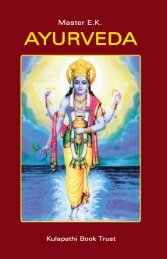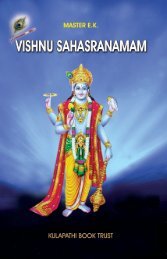The Yoga of Patanjali
By Master E.K.
By Master E.K.
You also want an ePaper? Increase the reach of your titles
YUMPU automatically turns print PDFs into web optimized ePapers that Google loves.
116 Lessons on <strong>The</strong> <strong>Yoga</strong> <strong>of</strong> <strong>Patanjali</strong>steps we have 27 respirations arranged in three groups <strong>of</strong> threesets <strong>of</strong> respirations. This forms one unit <strong>of</strong> practice. You cando one unit in the morning and one unit in the evening or nightaccording to your other items <strong>of</strong> the routine. Gradually youcan begin conducting a second unit <strong>of</strong> 27 breaths every day.After the first unit you can take a pause, talk to friends orattend to some work and then conduct the second unit.Sometimes you can continue any number <strong>of</strong> units accordingto your comfort, leisure and convenience. Let there be a minimum<strong>of</strong> one unit in the morning and another in the evening, the restbeing according to your convenience. Suppose you are waitingin the Air Port for a flight, or you are taking a flight. <strong>The</strong>n youcan silently conduct any number <strong>of</strong> units. After some time itbecomes effortless and automatic. Take care that it is notmechanical (without awareness) or monotonous (withdisinclination). Your awareness is the only thing which lifts youfrom the consciousness <strong>of</strong> your not-self to that <strong>of</strong> the Lordconsciousness.This is all about the breathing exercises. Nothingmore should be followed. As far as our group is concernedyou should exclusively follow this method because our grouphas to do everything with <strong>Patanjali</strong>, the Bhagavadgita and theMasters.Inhalation is called Prana and exhalation is called Apanain the language <strong>of</strong> <strong>Patanjali</strong> and Bhagavadgita. Prana includesall the in-drawing pulsations that are responsible for our receiving,reading, understanding, inhaling, eating, drinking etc. Apanaincludes the outpouring pulsations that include giving, <strong>of</strong>fering,explaining, exhaling and excreting. “Prana and Apana shouldbe brought to equilibrium and that is Pranayama” says theBhagavadgita.Having achieved the regulation <strong>of</strong> these two pulsations,we are directed towards the discipline <strong>of</strong> our daily activities.<strong>Patanjali</strong> calls it “<strong>The</strong> <strong>Yoga</strong> <strong>of</strong> Action” (Kriya <strong>Yoga</strong>). <strong>The</strong> whole






